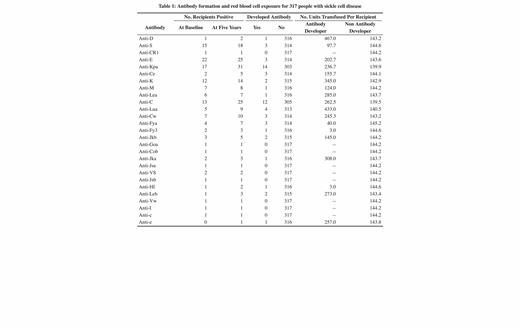Background
There is interest in strategies to match recipients to red blood cell (RBC) units for transfusion using antigens beyond ABO/Rh/K with the aim of reducing rates of alloantibody formation in heavily transfused people, for example sickle cell disease (SCD) and thalassemia (THAL). However, the efficacy of different strategies, often defined in national guidelines, is unknown. People with SCD/THAL in England are now offered free universal blood group typing using high-throughput, low-cost genotyping arrays, which will also be applied to 92,000 blood donors, extending the antigens available for matching. Key to an evaluation of the potential benefits of improved matching is an understanding of the patterns of alloimmunization, which have been reported to vary widely in SCD and THAL. We describe the distribution of alloantibodies in people with SCD/THAL, and evaluate the effect of transfusion exposure on the incidence of antibody formation alongside national guidelines.
Methods
In 2019 we performed a cross-sectional service evaluation of transfusion treatment for recipients with SCD and THAL at three comprehensive care centres in London, comparing practices against current British Society Haematology (BSH) guidelines, which require matching for compatibility with ABO/Rh/K antigens. We collated and curated data on red cell antigens and antibodies and transfusion treatment regimens from hospital records. Subsequently, at the largest centre, we collated additional longitudinal data on antigens, antibodies and treatment from hospital records retrospectively for the 5 years ending on 31st December 2022. The longitudinal cohort overlapped substantially with the recipients contributing to the cross-sectional service evaluation. Appropriate local and national (22/EM/0006) governance approvals were obtained.
Results
For the service evaluation, we collated data on 2,025 people: 1,331 SCD (of whom 199 regularly transfused); 453 THAL (of whom 257 regularly transfused). The prevalence of at least one antibody was 14% and 20% in SCD and THAL recipients respectively, and 26% and 24% in regularly transfused SCD and THAL recipients respectively. The commonest antibodies in SCD were anti-S (3.2% prevalence), anti-E (2.9% prevalence), anti-Kp(a) (2.3% prevalence) and anti-K (2.1% prevalence); and in THAL were anti-K (7.1% prevalence), anti-E (6.8% prevalence), anti-Kp(a) (6.6% prevalence) and anti-C (2.2% prevalence).
We collated longitudinal data on 676 people treated at the largest centre, of whom 443 had a complete five-year transfusion history. Over five years, 317 SCD recipients received 45,707 RBC units of whom 46 developed new antibodies (Table 1); 126 THAL recipients received 15,251 RBC units and two developed new antibodies. In total, there were 57 alloimmunization events in SCD recipients and 3 in THAL recipients. The antibodies with the greatest frequency of incident formation were anti-Kp(a) (14 events) and anti-C (12 events), all in SCD.
For each antibody, we calculated the number of antigen negative units required to eliminate the possibility of incident alloimmunization in the cohort, assuming transfusion was equally distributed across antigen types e.g. 93% of the 676 recipients are Fy(a) neg, so 0.93 x 45,707 units = 42,508 Fy(a) negative units would need to be supplied over 5 years to ensure that no Fy(a) negative recipients are exposed to Fy(a) positive blood.
Conclusions
The risk of new alloimmunization differs between THAL and SCD. In SCD, anti-Kp(a) and anti-C account for almost 50% of new alloimmunization. Most of the antibodies (anti C/E/K) prevalent in our longitudinal cohort are likely to have been formed before the introduction of the current matching strategies defined in national guidelines. Many people who are antigen negative never form cognate antibodies to the corresponding antigen, despite extensive transfusion exposure. Guidance around extended matching beyond ABO/Rh/K may not match the antibodies that are most commonly newly formed in SCD, but may not be indicated in THAL. Further studies are required to determine who will benefit from more precise RBC matching, given the relative paucity of antigen negative blood in donor populations, such as planned by novel algorithmic real-time approaches in the Haem-Match programme (www.haemmatch.org).
Disclosures
Gleadall:Thermo Fisher: Consultancy. Ouwehand:Thermo Fisher: Consultancy, Other: has donated this to an education fund.


